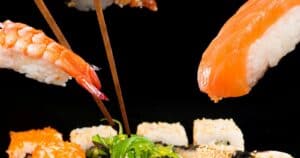I know what you’re thinking – how could sushi ever be considered a cheat meal? With its fresh fish and whole grains, it seems like one of the healthiest takeout options around. However, before you go all-out at the sushi bar, there are a few factors to consider:
- The calorie count can add up fast depending on the type of sushi rolls and how much you eat. Some rolls with fried ingredients or sauces pack 300-500 calories each! It’s easy to underestimate your intake when the portions are small.
- Loading up on high-sodium options like soy sauce can send your sodium levels through the roof. This can lead to bloating and water retention, putting a damper on your healthy eating goals.
- Overdoing it on white rice can spike your blood sugar and pack on the carbs. Sushi restaurants sometimes serve huge bowls of rice with meals. Practice portion control to keep your cheat meal in check.
The good news is sushi can be a nutritious and balanced meal when ordered wisely. Stick to rolls with fresh fish, veggies, and brown rice. Watch your portion sizes, and resist the urge to dive face first into the soy sauce. With a little restraint, you can enjoy sushi guilt-free!
Now that you know the cheat meal pitfalls to avoid, let’s dive into the do’s and don’ts of ordering healthy sushi that aligns with your fitness goals…
Calorie Count Adds Up Fast
Sushi’s small portion sizes are deceiving. It’s easy to underestimate how many calories you’re taking in when you’re essentially just eating bite-sized pieces the whole time.
Some popular sushi rolls pack 300-500 calories each. And it doesn’t take much to eat 4-5 rolls in one sitting at a sushi restaurant. That’s like eating a large burger and fries in terms of calories!
Factors that increase the calorie count:
- Fried ingredients like tempura or spicy mayo
- Avocado, which is high in healthy fats – but still high in calories
- Larger portion of rice
- Extra sauces and dressings
So if you’re watching your daily calorie intake, it’s smart to 1) opt for simpler, vegetable-based rolls and 2) stop eating when you feel satisfied rather than stuffed.
Sodium Overload
You know that feeling when you leave the sushi restaurant feeling bloated and puffy? That’s likely due to excess sodium causing water retention.
Soy sauce, pickled ginger, and some sushi recipes contain large amounts of sodium. Dipping each piece in soy sauce really makes the sodium content skyrocket.
To avoid bloating and excess water weight:
- Ask for rolls to be made without soy sauce
- Use ginger and wasabi instead of soy sauce for flavor
- Limit sodium-heavy ingredients like tempura
- Drink plenty of water to flush out sodium
Moderating your soy sauce usage is key to preventing that unwanted sushi bloat!
Spiking Your Blood Sugar
Sushi is centered around white rice, a high glycemic index food. This means it can cause a quick spike and crash in blood sugar levels.
Overdoing it on the white sushi rice can pack on the refined carbs. This leads to inflammation, low energy, and cravings. Not so slimming!
Some tips for balancing your blood sugar:
- Opt for brown rice sushi or sashimi (no rice)
- Eat sushi with veggies or side salad to add fiber
- Limit rice portions to 1⁄2 – 1 cup
- Avoid sugary drinks, which compound blood sugar issues
Being mindful of portions and pairing rice with protein and fiber can help prevent blood sugar spikes.
It’s Easy to Overeat
When we eat mindlessly, it’s easy to take in way more calories than we realize. Sushi restaurants often have all-you-can-eat deals, unlimited appetizers, and large portion sizes.
With plates of sushi, bowls of rice, and deep-fried options within arm’s reach, it’s no wonder sushi meals can lead to overeating.
Here are some tips for practicing portion control:
- Pause halfway through your meal and check if you’re still hungry
- Help fill up on miso soup and salad first
- Put your chopsticks down between pieces
- Split rolls or sashimi orders with a friend
- Skip the all-you-can-eat specials if you know you have a big appetite
Listening to your body’s fullness signals can go a long way in preventing sushi binges.
Healthy Sushi IS Possible
Here’s the good news – you CAN enjoy sushi as part of a healthy diet and lifestyle. You just have to be a mindful consumer.
Follow these guidelines at your next sushi outing:
Choose Nutrient-Dense Ingredients
- Load up on veggies – avocado, cucumber, asparagus, etc
- Pick lean protein – salmon, tuna, shrimp, scallops
- Ask for brown rice to up the fiber
- Add omega-3 rich options like salmon roe
- Limit fried ingredients like tempura
Watch Portion Sizes
- Stick to 2-3 rolls max or 12-15 pieces of sashimi
- Pour soy sauce into a small dish for dipping rather than dousing pieces
- Order a side salad instead of just rice
- Share an order of dumplings or spring rolls instead of having your own
Balance Your Meal
- Start with miso soup and salad
- Pair sushi with a green tea instead of soda
- Avoid all-you-can-eat sushi specials
- Split dessert with friends instead of getting your own
Yes, you can enjoy sushi as a cheat meal occasionally. But with a few simple tweaks, sushi can also be a fresh, nutritious meal that leaves you feeling satisfied instead of stuffed.
The key is choosing rolls wisely, paying attention to portions, and balancing out your meal. Sushi can be an awesome way to get in those omega-3s from fish and fit in more veggies. Just be mindful of the cheat meal pitfalls like fried goods, sodium overload, and overeating.
Now that you know how to make sushi work within your healthy eating plan, go ahead and grab those chopsticks! Just remember to practice a little mindful moderation.





